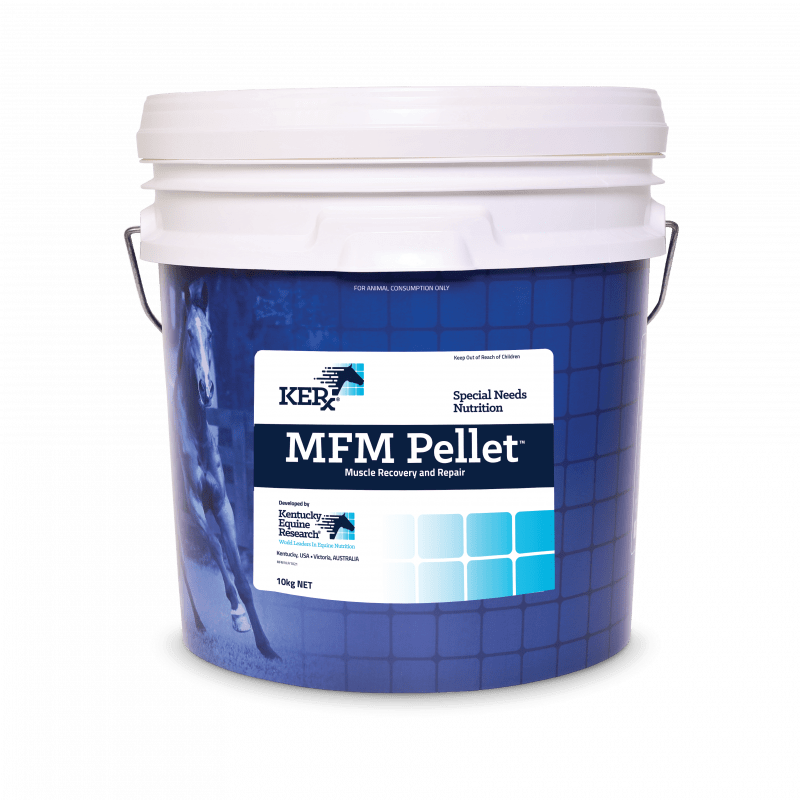MFM Pellet contains several important amino acids, including cysteine, a key component in many antioxidants. Also included in MFM Pellet
are the branched-chain amino acids (BCAA) leucine, isoleucine, and valine, all three of which are essential amino acids that must be
obtained from the diet. BCAA may be used as a substrate for energy production in skeletal muscle. Research in human athletes has shown
that BCAA may stimulate protein synthesis and delay onset of fatigue. MFM Pellet also contains the essential amino acids lysine,
methionine, and threonine.
The understanding of muscle disease in horses has broadened considerably over the last few decades. Researchers continue to discover nuances
in muscle dysfunction, and one disease continues to gain recognition within the Warmblood and endurance communities: myofibrillar myopathy
(MFM).
Like those diagnosed with polysaccharide storage myopathy (PSSM), horses with MFM demonstrate exercise intolerance and occasional episodes
of tying-up. Microscopic examination of muscle tissue reveals, however, that the underlying cause of MFM is much different than it is for
PSSM.
Cross sections of muscle cells. Left, a healthy horse. Center, a horse with MFM showing desmin aggregates in the muscle. Right, the same
horse on MFM Pellet.
Sarcomeres are the basic contractile units of muscle fiber. Each sarcomere is composed of two main protein filaments, actin and myosin,
which are the structures responsible for muscular contraction. These structures lie side by side in a staggered formation, while another
protein called desmin stabilizes the filaments to maintain their alignment. In horses with MFM, the alignment between the actin and myosin
strands fails, causing tears and gaps in the filaments. Muscle biopsies of affected horses show abnormal desmin deposits at these disruption
sites.
While researchers remain unsure why these changes in myofibrils occur, MFM has been identified and studied most extensively in two groups of
horses, Warmbloods and Arabians. Crossbred horses of Arabian and Warmblood breeding as well as horses of unrelated breeds have also been
affected. Warmbloods typically show exercise intolerance by the time they are six to eight years of age. This is characterized
by an unwillingness to go forward, inability to achieve or maintain collection, reduced capacity for routine work, and difficulty with
upward transitions to canter. Muscle pain, stiffness, and vague hindlimb lameness are also signs of MFM in Warmbloods.
Note that these signs are not specific to MFM and they can occur with poor saddle fit, lameness from hock or stifle degeneration, suspensory
injuries, sacroiliac disorders, inflammation of thoracic or lumbar vertebrae, and more. A thorough evaluation for lameness is needed to rule
out these more common issues and should precede any testing for MFM horses.
According to Valberg, the “basis for MFM in Warmblood horses appears to be related to the individual effects of diet, exercise, and training
on gene and protein responses to exercise with downstream effects on muscle mass, the alignment of contractile proteins, mitochondrial
function, and oxidative stress.”
Arabians diagnosed with MFM are typically engaged in endurance riding. Horses have irregular elevations in serum creatine kinase activity
after endurance rides or during exercise that follows a week or more of rest. Elevated creatine kinase is a sign of muscle damage. Other
signs of tying-up, such as sweating, pain, and reluctance to move, are hit-or-miss and oftentimes less severe than those signs exhibited by
horses with other forms of exertional rhabdomyolysis. Discolored urine has been noted in Arabian horses with only slight muscle stiffness.
The basis for MFM in Arabian horses appears to be related to a need for increased cysteine synthesis, decreased cysteine-based antioxidants,
and oxidative stress. With this in mind, these horses would have an increased requirement for cysteine following exercise.
Like PSSM2, the diagnosis can only be made by muscle biopsy and there are no valid genetic tests for MFM. Diagnosis must be made by muscle
biopsy.
.png)
